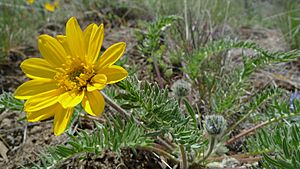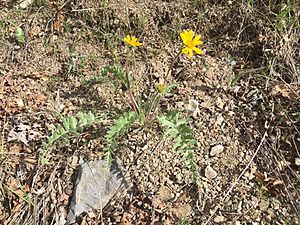Hooker's balsamroot facts for kids
Quick facts for kids Hooker's balsamroot |
|
|---|---|
 |
|
| Balsamorhiza hookeri in flower on Badger Mountain, Douglas County Washington | |
| Scientific classification | |
| Genus: |
Balsamorhiza
|
| Species: |
hookeri
|
| Synonyms | |
|
|
Balsamorhiza hookeri (also known as Hooker's balsamroot) is a type of plant that lives for many years. It belongs to the sunflower family, just like the sunflowers you might see in a field! This plant grows naturally in the Great Basin area and nearby regions in the western United States. You can find it in states like Washington, Oregon, California, Idaho, Nevada, Utah, and Arizona.
Contents
What Does Hooker's Balsamroot Look Like?
Leaves and Stems
Hooker's balsamroot has special leaves that are divided into many smaller parts, almost like a feather. These smaller parts are also deeply cut or lobed. The leaves at the bottom of the plant can be quite long, up to about 40 centimeters (16 inches). These basal leaves are usually covered in fine hairs. The main stem of the plant does not have leaves and is also hairy.
Flowers and Blooming Time
This plant blooms from April to July, showing off its bright, sunflower-like flowers. Each flower head is about 2.5 to 7.5 centimeters (1 to 3 inches) wide. They have 10 to 21 "ray flowers" around the edge, which look like petals and often have fringed tips. In the center, there are many tiny "disc flowers" packed together.
Where Does Hooker's Balsamroot Grow?
Hooker's balsamroot likes to grow in dry, grassy areas. You can find it in places like sagebrush steppe (a type of dry grassland with sagebrush plants) and in mountain plant communities. It can grow at high elevations, up to about 2,740 meters (9,000 feet) above sea level, especially in the Great Basin region.
How Does It Interact with Other Plants?
This plant often grows in rocky places. Its close relative, the arrow-leaf balsamroot (Balsamorhiza sagittata), prefers less rocky soil and has leaves shaped like arrows. Interestingly, Hooker's balsamroot can sometimes mix with arrow-leaf balsamroot. When they do, they create a new plant that has leaves which are arrow-shaped but also deeply divided, showing features from both parent plants.


